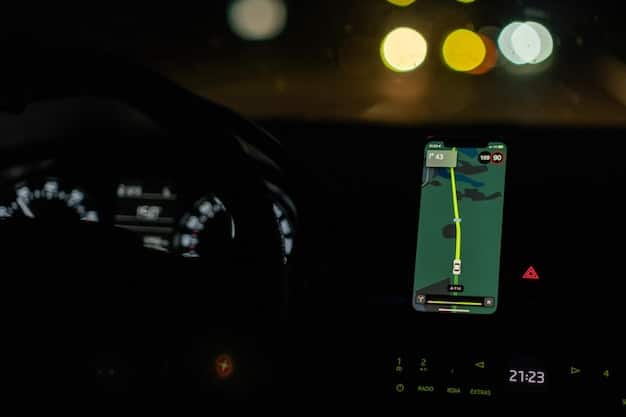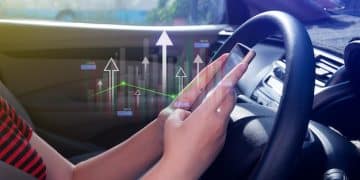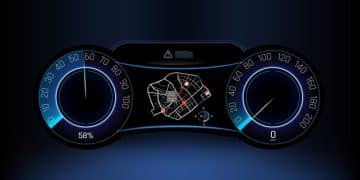AR Dashboards: The Future of Driver Information Systems?

Augmented Reality (AR) dashboards are poised to revolutionize driver information systems by overlaying crucial data onto the windshield, enhancing situational awareness and potentially improving safety and efficiency for drivers.
Are Augmented Reality (AR) dashboards: Are They the Future of Driver Information Systems? Imagine a world where vital driving data seamlessly blends with your view of the road, creating a safer and more intuitive driving experience.
The Evolution of Driver Information Systems
Driver information systems have evolved drastically over the years, from simple speedometers and fuel gauges to sophisticated digital displays. However, the core concept remains the same: to provide drivers with essential information about their vehicle and surroundings.
Traditional dashboards can be distracting, requiring drivers to take their eyes off the road. Augmented reality offers a potential solution by integrating information directly into the driver’s field of view.
From Analog to Digital: A Historical Overview
Early vehicles relied on analog gauges to display crucial information. These gauges were simple but effective. As technology advanced, digital displays gradually replaced analog ones, offering more information and greater customization.
The Rise of Heads-Up Displays (HUDs)
Heads-Up Displays (HUDs) marked a significant step forward, projecting information onto the windshield and reducing the need for drivers to look down. However, early HUDs were often limited in terms of color, brightness, and the amount of information they could display.
- Analog Gauges: Simple, reliable, but limited in functionality.
- Digital Displays: More information, greater customization, but potentially distracting.
- Heads-Up Displays (HUDs): Improved safety by projecting information onto the windshield.
The progression of driver information systems has always aimed at providing more data while minimizing driver distraction. Augmented reality dashboards represent the next logical step in this evolution.
What are Augmented Reality Dashboards?
Augmented Reality (AR) dashboards take the concept of HUDs to the next level by overlaying digital information onto the real-world view. These dashboards use cameras, sensors, and advanced software to create a seamless blend of physical and digital elements.
Unlike traditional HUDs that project a limited amount of information onto a small area of the windshield, AR dashboards can display a wider range of data and adapt to changing driving conditions.

Key Components of AR Dashboards
AR dashboards consist of several key components, including cameras, sensors, processing units, and display technologies. These components work together to capture, analyze, and present information in real-time.
How AR Dashboards Enhance Situational Awareness
By overlaying information such as navigation directions, speed limits, and potential hazards onto the driver’s view, AR dashboards can significantly enhance situational awareness. This can lead to quicker reaction times and improved safety.
- Real-time Data: AR dashboards provide up-to-the-second information about vehicle status and surroundings.
- Enhanced Navigation: Clear visual directions overlaid directly onto the road.
- Hazard Detection: Early warnings of potential dangers, such as pedestrians or obstacles.
AR dashboards represent a paradigm shift in how drivers interact with their vehicles, making driving safer, more efficient, and more enjoyable.
Benefits of Implementing AR in Driver Information Systems
Implementing AR in driver information systems offers a plethora of benefits, ranging from enhanced safety to improved driver comfort and convenience. These advantages stem from AR’s ability to provide contextually relevant information directly within the driver’s line of sight.
By reducing the need to look away from the road, AR dashboards can help prevent accidents and improve overall driving performance.
Improved Safety and Reduced Distraction
One of the primary benefits of AR dashboards is their ability to improve safety by reducing driver distraction. With crucial information displayed directly in their field of view, drivers are less likely to take their eyes off the road.
Enhanced Navigation and Route Guidance
AR dashboards offer enhanced navigation and route guidance by overlaying turn-by-turn directions onto the real-world view. This makes it easier for drivers to follow routes and anticipate upcoming turns.
- Collision Avoidance: AR systems can detect potential collisions and provide timely warnings.
- Lane Departure Warnings: AR can alert drivers when they unintentionally drift out of their lane.
- Adaptive Cruise Control: AR can enhance adaptive cruise control by providing visual feedback on following distance and speed adjustments.
The integration of AR into driver information systems opens new avenues for enhancing driver safety and convenience, paving the way for a more connected and intelligent driving experience.
Challenges and Limitations of AR Technology in Vehicles
Despite the numerous benefits of AR dashboards, there are also several challenges and limitations that need to be addressed. These include technological hurdles, cost considerations, and regulatory concerns.
Overcoming these challenges will be crucial for the widespread adoption of AR technology in vehicles.
Technological Hurdles and Implementation Challenges
Developing and implementing AR dashboards requires advanced technologies such as high-resolution displays, powerful processing units, and sophisticated sensor systems. These technologies can be complex and expensive.
Cost and Affordability for Consumers
The high cost of AR technology can be a barrier to entry for many consumers. AR dashboards are currently found in high-end vehicles, but their widespread adoption will depend on making them more affordable.
- Hardware Limitations: Current AR displays may suffer from limited brightness, contrast, and field of view.
- Software Reliability: AR systems must be reliable and accurate in all driving conditions.
- Data Security: Protecting driver data and preventing hacking are critical concerns.
Addressing these challenges will be essential for unlocking the full potential of AR technology in vehicles and bringing its benefits to a wider audience.

The Future of AR Dashboards and Driver Experience
The future of AR dashboards looks promising, with ongoing advancements in technology and increasing interest from automakers and consumers. As AR technology becomes more mature and affordable, it is likely to play an increasingly important role in shaping the driver experience.
AR dashboards have the potential to transform the way we interact with our vehicles and the world around us.
Potential Advancements and Innovations
Future AR dashboards may incorporate advanced features such as personalized information displays, augmented reality-based safety warnings, and seamless integration with other vehicle systems.
The Role of AR in Autonomous Vehicles
As vehicles become more autonomous, AR dashboards can play a critical role in providing passengers with information about the vehicle’s surroundings and planned actions. This can help build trust and confidence in self-driving technology.
- Personalized Information: AR dashboards can adapt to individual driver preferences and needs.
- Context-Aware Assistance: AR systems can provide real-time assistance based on driving conditions and driver behavior.
- Entertainment Integration: AR can enhance the in-car entertainment experience by overlaying digital content onto the real world.
AR dashboards are poised to revolutionize the driver experience, making driving safer, more enjoyable, and more connected than ever before. The continued development and refinement of AR technology will undoubtedly shape the future of transportation.
Adoption and Market Trends of AR Dashboards
The adoption and market trends of AR dashboards are influenced by various factors, including technological advancements, consumer demand, and regulatory frameworks. Understanding these trends is crucial for predicting the future of AR in the automotive industry.
The market for AR dashboards is expected to grow significantly in the coming years as more automakers integrate this technology into their vehicles.
Current Market Penetration and Growth Rate
While AR dashboards are currently found in a relatively small number of high-end vehicles, their market penetration is expected to increase rapidly in the coming years. This growth is driven by increasing consumer demand for advanced safety features and enhanced driving experiences.
Consumer Perception and Acceptance
Consumer perception and acceptance of AR dashboards are generally positive, with many drivers appreciating the enhanced safety and convenience they offer. However, some drivers may feel overwhelmed by the amount of information displayed on the windshield.
- Automaker Investments: Major automakers are investing heavily in AR technology.
- Partnerships and Collaborations: Technology companies are partnering with automakers to develop AR solutions.
- Regulatory Support: Governments are developing regulatory frameworks for AR in vehicles.
The adoption of AR dashboards is set to accelerate as technology improves, costs decrease, and consumer awareness grows. This will lead to a new era of safer and more connected driving experiences.
| Key Point | Brief Description |
|---|---|
| 🚗 Enhanced Safety | AR reduces distractions and provides real-time alerts. |
| 🗺️ Navigation | AR overlays turn-by-turn directions on the road for easier guidance. |
| 💡 Future Trends | AR will integrate with autonomous vehicles and enhance user experience. |
| 💰 Cost Factors | Currently expensive, but costs are expected to decrease over time. |
FAQ
▼
AR dashboards primarily enhance safety by reducing driver distraction and providing real-time alerts. They also improve navigation by overlaying directions onto the road and offer a more intuitive driving experience.
▼
No, AR dashboards are currently mainly available in high-end or luxury vehicles. However, as the technology advances and costs decrease, wider adoption across different car models is anticipated in the future.
▼
Potential limitations include technological hurdles such as display quality and processing power, challenges related to implementation reliability, particularly in varying weather conditions, and the need to protect driver data security.
▼
AR dashboards enhance navigation by projecting turn-by-turn directions directly onto the driver’s view of the road. This makes it easier to follow routes, anticipate turns, and stay focused on the driving environment.
▼
In autonomous vehicles, AR dashboards will provide passengers with essential information about the vehicle’s surroundings and planned actions. This transparency helps build trust and confidence in self-driving technology, enhancing the overall experience.
Conclusion
In conclusion, Augmented Reality (AR) dashboards hold tremendous potential to revolutionize driver information systems. By enhancing safety, improving navigation, and offering a more intuitive driving experience, AR dashboards are poised to become a key feature in future vehicles. While challenges remain in terms of technology and cost, ongoing advancements and increasing adoption suggest that AR dashboards are indeed the future of driver information systems.





